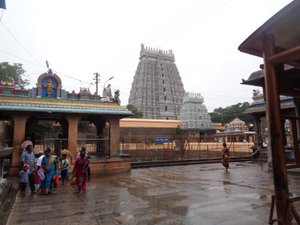Advertisement
Published: December 17th 2019

 DSC00639
DSC00639
Arulmigu Arunachaleswarar Temple, Thiruvannamalai. After spending 2 days in Kanchipuram 12th &13th Dec 2019. Started to Tiruvannamalai at 5.45 am by Selam bus reached Tiruvannamali by 9.10 am ie 3 &1/2 hours.
Immediately took an auto to visit & pray Arulmigu Arunachaleshwar Temple Thiruvannamalai (http://www.arunachaleswarartemple.tnhrce.in/). It took 1 & 1/2 hours to get darshanam. There is a Rs 20 ticket for a priority queue but that is also heavily populated. You can not spend much time in front of the Diety. The temple is an excellent and good pious atmosphere. within the campus, there is Parvathy temple known as
Arultharum Unnamulaiamman After having darshan Arulmigu Arunachaleshwar Temple set out for the darshan of Ashta Lingas ( 8 different Shiva Lingam small temple around Tiruvannamali pradkshinam route. The Lingas include Panchbhutam
Tiruvannamalai is one of the greatest Saivite shrines in Tamil Nadu,India, on a sprawling 24 acre temple campus, drawing hundreds of thousands of pilgrims every full moon. The hill here is considered to be a manifestation of Shiva. Tiruvannamalai is one of the Panchabhoota Stalams signifying the 5 elements of wind (Kalahasti), water (Tiruvanaikka), fire (Tiruvannamalai), earth (Kanchipuram) and space (Chidambaram). Kartikai Deepam festival here is of great significance

 DSC00640
DSC00640
Arulmigu Arunachaleswarar Temple, ThiruvannamalaiThis temple, dedicated to the god Shiva, was built between the 16th and the 17th centuries by the kings of the Vijayanagara empire. The temple is famous for its massive gopurams. The 11 tiered East Rajagopuram towers to a height of 217 feet, while the fortified walls pierced with 4 gopura entrances offer a formidable look to this vast temple complex. The Pei Gopuram, Tirumanjana Gopuram, and Ammanaiammal gopuram are the other three. The 1000 pillared hall and the temple tank were built by Krishna Deva Rayarar of Vijayanagar. Each of the prakarams has a huge Nandi and several towers such as the Vallala Maharaja Gopuram and Kili Gopuram It is one of the panchabhoota sthalam - representing five basic elements. This is the Tejo Sthalam among the Pancha Bootha Sthalams representing Fire. The others are - Tiruvanaikavil (Appu sthalam - Water) Kanchipuram (Prithvi sthalam - Earth) Kalahasti (Vayu sthalam - Air) Chidambaram (Akasa sthalam - Space)
Sri Pathala Lingam
Sri Ramana Maharshi stayed at various places in Tiruvannamalai and then in several caves on the Arunachala Hill until he finally settled at what came to be called Sri Ramanasramam where he lived until his

 DSC00641
DSC00641
Arulmigu Arunachaleswarar Temple, ThiruvannamalaiMahanirvana in April 1950. He never took formal sannyasa nor did he claim to have any disciples. From the day he arrived in 1896 until his Mahanirvana, Ramana never left his beloved Arunachala.
The first place that Ramana stayed in Tiruvannamalai was the great temple. For a few weeks, he remained in the thousand-pillared hall. But he was soon troubled by the urchins who pelted him with stones as he sat silently. He shifted to an underground vault known as Patala Lingam, where the sunlight never penetrated. Without moving he sat deeply absorbed in the Self and was unaware of being bitten up by the ants and vermin living there.
The Eight Lingams on Arunachala’s Pradakshina Route (GIRIVALAM) Each of these eight lingams has a presiding star and is named for a God or Rishi that worshiped Siva (from this very location, it is often said). Each has a specific spiritual attribute. Each can provide assistance with some kind of major life issue, or illness
Ashtalingams At Tiruvannamalai
Indra Lingam
Agni Lingam
Yama Lingam
Niruthi Lingam
Varuna Lingam
Vayu Lingam
Kubera Lingam
Sri Seshadri Swamigal Asram In

 DSC00642
DSC00642
Arulmigu Arunachaleswarar Temple, ThiruvannamalaiPathala Lingam I explained when Ramana Maharshi was disturbed by locals it was Seshadri swamigal who intervened and protected 16-year-old Ramana
Seshadri Swamigal was born on January 22, 1870. As a child, he had spontaneous trances. At age four Seshadri received his nickname, 'Golden Hand'.
At the age of 19, he met Sri Balaji Swamigal, a wandering saint from North India, who gave Seshadri sannyas and instructed him in the Mahavakyas. Shortly after Seshadri started to travel to various spots in Tamil Nadu eventually ending up at Tiruvannamalai, at the age of 19. Seshadri Swami moved about Tiruvannamalai for 40 years, an ascetic with a total disregard for either name or form.
Throughout his life and teachings, Sri Seshadri continuously emphasized the glory of Arunachala. He often talked about the unique aspects of the Arunachala kshetra. He would say: 'This is the place where Swamy and Ambal invite all and confer liberation', and 'Lord Krishna leaving aside his sudarshana chakra (divine weapon) is playing on his flute. On hearing it Lord Siva who is inside the mountain comes out and dances'.
Sri Seshadri Swami had deep devotion to God, especially in the form of the Goddess

 DSC00643
DSC00643
Arulmigu Arunachaleswarar Temple, ThiruvannamalaiKamakshi, Lord Ram, and Arunachala. Sri Seshadri was a great worshipper of Shakti. In the practice of concentration, he sat steeped in samadhi, oblivious of his body
Sri Ramanasram (https://www.sriramanamaharshi.org/)
Sri Ramana Ashram, also known as Sri Ramanasramam, is the ashram which was home to modern sage and Advaita Vedanta master Ramana Maharshi from 1922 until his death in 1950.It is situated at the foot of the Arunachala hill, to the west of Tiruvannamalai, Tamil Nadu, where thousands of seekers flocked to be in his presence. His samadhi shrine continues to attract devotees from all over the world.
Ramana Maharshi (30 December 1879 – 14 April 1950) was an Indian sage. He was born Venkataraman Iyer, but is most commonly known by the name Bhagavan Sri Ramana Maharshi.
He was born in what is now Tiruchuli, Tamil Nadu, India. In 1895, an attraction to the sacred hill Arunachala and the 63 Nayanmars was aroused in him, and in 1896, at the age of 16, he had a "death-experience" where he became aware of a "current" or "force" (avesam) which he recognised as his true "I" or "self", and which he later identified with "the

 DSC00644
DSC00644
Arulmigu Arunachaleswarar Temple, Thiruvannamalaipersonal God, or Iswara",that is, Shiva. This resulted in a state that he later described as "the state of mind of Iswara or the jnani". Six weeks later he left his uncle's home in Madurai, and journeyed to the holy mountain Arunachala, in Tiruvannamalai, where he took on the role of a sannyasin (though not formally initiated), and remained for the rest of his life.
He soon attracted devotees who regarded him as an avatar and came to him for darshan ("the sight of God"), and in later years an ashram grew up around him, where visitors received upadesa ("spiritual instruction") by sitting silently in his company asking questions. Since the 1930s his teachings have been popularized in the West, resulting in his worldwide recognition as an enlightened being.
Ramana Maharshi approved a number of paths and practices, but recommended self-enquiry as the principal means to remove ignorance and abide in Self-awareness, together with bhakti (devotion) or surrender to the Self
Virupaksha cave Arunachala refers to the holy hill at Thiruvannamalai in Tamil Nadu. The hill also is known by the names Arunagiri, Annamalai Hill, Arunachalam, Arunai, Sonagiri, and Sonachalam
It is one of the five

 DSC00645
DSC00645
Arulmigu Arunachaleswarar Temple, Thiruvannamalaimain shaivite holy places in South India. It is also an important place for devotees of Sri Ramana Maharshi, with Sri Ramana Ashram situated at its foothills.
Over the centuries, many saints and sages have been drawn to Arunachala. In the fifteenth century, Guhai Namasivaya, Guru Namasivaya, and Virupaksha Deva came from Karnataka and settled on Arunachala. Saint Namasivaya lived in one of Arunachala's caves which are still known by his name.
Virupaksha Deva lived in an OM-shaped cave higher up on the Hill, and this cave too still bears his name. Located on the south-east slope of Arunachala, this was the cave that Sri Ramana Maharshi lived in from 1899 to 1916.
Yogi Ramsuratkumar Ashram (http://www.yogiramsuratkumarashram.org/)
Yogi Ramsuratkumar (December 1, 1918 – February 20, 2001) was an Indian saint and mystic. He was also referred to as "Visiri samiyar" and spent most of his post enlightenment period in Tiruvannamalai, a small town in Tamil Nadu which is famous for attracting spiritual seekers worldwide and has had a continuous lineage of enlightened souls. He acknowledges the contribution of three of the most well known saints of his time in his evolution to enlightenment. These individuals were Sri Aurobindo,

 DSC00646
DSC00646
Arulmigu Arunachaleswarar Temple, Thiruvannamalaithe founder of Integral yoga, Ramana Maharshi, one of the "spiritual supermen" of his time, and Swami Ramdas, Yogi's eventual guru
He grew up as a Grihasta but eventually, the tugs of spirituality in his heart took over. In search of his "guru", he visited and spent time in the ashrams of both Sri Aurobindo and Ramana Maharishi. He later moved to Kerala at the ashram of Swami Ramdas. In his own assessment, Sri Aurobindo gave him Jnana, Sri Ramana Maharshi blessed him with tapas and Swami Ramdas gave him the nectar of Bhakti. Swami Ramdas initiated him into the holy mantra : " Om Sri Ram Jai Ram Jai Jai Ram ", by pronouncing it thrice in his ears. Yogi Ramsuratkumar often refers to this instance as his "death", since from this moment on, his ego no longer existed, and he had a profound spiritual experience.
Yogiji traveled across the country from 1952 to 1959. Not much is known about the exact whereabouts of the yogi in this period. He finally reached Tiruvannamalai in the Southern India in 1959. He was a "hidden" saint during this early period, with not too many individuals realizing that this "beggar"

 DSC00647
DSC00647
Arulmigu Arunachaleswarar Temple, Thiruvannamalaiwas someone who would bring riches to the lives of countless many. He was seen near the Temple chariot, at the corners of the Road, under the trees of the Temple. As more and more people started acknowledging the divine presence in him, Swamiji then began living in a small house in Sannadhi Street beneath the Temple. He continued to bless the devotees who thronged at thousands to his house at the Sannadhi Street. At a point, his devotees became too many to be handled in a small house and the devotees wished him to have an Ashram which he gently accepted after much persuasion for the sake of his devotees. The Yogi Ramsuratkumar Ashram is constructed at Agrahara collai with a total area of 3.5 Acres.
Note : There are totally 123 Photos on this Blog use next button to see all the photos
Advertisement
Tot: 0.101s; Tpl: 0.013s; cc: 10; qc: 45; dbt: 0.0458s; 1; m:domysql w:travelblog (10.17.0.13); sld: 1;
; mem: 1.2mb




















